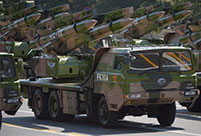

Chinese Premier Li Keqiang met with domestic and foreign business representatives on Wednesday afternoon ahead of the Ninth Annual Meeting of the New Champions, also known as the Summer Davos forum.
The following is the full text of the meeting:
Li Keqiang: Professor Schwab, ladies and gentlemen, let me first send my congratulations on the opening of the ninth Annual Meeting of the New Champions in Dalian. It' s good to see so many familiar faces and old friends in the audience. As the place is so packed today, it' s difficult for me to walk into the audience and shake hands with each one of you. But I do appreciate the interest you have shown in China by coming to the meeting and your participation in China' s modernization process. I am very happy to meet you here, because each time I come to the annual meeting, I get some new food for thought. The theme of the annual meeting this year - Charting a New Course for Growth - is highly relevant. I look forward to sharing my views and observations with you on this topic.
Pau Polman, CEO of Unilever: We are all following the world economy very closely. In our brief discussion just now, you mentioned the slowing down of global growth, including China itself. What you said is very important, making us optimistic in the future of the Chinese economy. You also mentioned the need to find new drivers for growth. What are the new drivers specifically? As China takes over the chairmanship of the G20 next year, what agenda have you set for the G20 summit? How could this agenda bring about more sustainable, equitable and longer-term growth?
Li Keqiang: It has been seven years since the global financial crisis broke out. Global growth remains sluggish. It' s true that the Chinese economy has come under downward pressure. I know that you all follow the Chinese economy very closely. The "shape" of the economy is that there have been some ups and downs, but the underlying trend remains positive. In the first half of this year, the Chinese economy expanded by 7%, which is one of the highest among the world' s major economies.
I have said on several occasions, a GDP growth that secures sufficient employment, increase in household income in step with GDP growth and improvement in the environment would be one that we can live with. In the first half of this year, surveyed urban unemployment rate was around 5.1%. And we added over 7 million urban jobs. All these show that the Chinese economy has been running within the proper range.
Talking about new drivers of economic growth, we are encouraging mass entrepreneurship and innovation. Thanks to business registration reform and other reforms as well as mass entrepreneurship and innovation, over 10,000 new market entities are registered on an average daily basis since last year. There are also positive changes in the economic structure. For instance, consumption is contributing about 60% to China' s economic growth. The service sector now accounts for almost 50% of GDP. Growth of high-tech industries is over 10%. All these are the changes we have been promoting, and we feel heartened by these developments.
There has been overall stability in China' s economic performance, despite certain moderation in speed. The overall trend is positive, yet there are also difficulties to overcome. We are pressing ahead with structural reform to advance structural adjustment. As the traditional growth drivers get replaced by new ones, it is only natural to see fluctuations in some of the economic indicators on a monthly or quarterly basis. This has happened this year, last year and the year before last as well. The economy is still running within the proper range. We will stick to the basic orientation of our macroeconomic policy. We will continue to advance reform and opening-up, and promote structural adjustment. We will also step up ranged-based, targeted and discretionary macro regulation to maintain steady economic growth within the proper range. All these will create enabling conditions for structural reform and adjustment.
We will not be swayed by short-term fluctuations in certain economic indicators, but we will not take them lightly either. We are prepared to undertake preemptive adjustment and fine-tuning as appropriate, and step up targeted macro regulation. I am confident that the Chinese people have the wisdom and the Chinese government has the capability to maintain medium-high speed of growth and achieve medium-high level of development. The G20 summit is going to be held in China next year. The agenda is still being discussed among the parties. China will play a constructive role in this process.
Thank you.
Schwab: Mr. Premier, I think you gave us, as far as the economic situation is concerned, a reassuring message. But I would like to return to capital market and financial risks which have been very much on the mind of the media and the world recently.
Yorihiko Kojima, Chairman of Mitsubishi: My question is about financial risks. Our company has offices in 90 countries worldwide. China, including its stock market and debt, has attracted close global attention. What will the Chinese government do about the financial reform? This is very important for our company and customers. When will the reform measures be announced?
Li Keqiang: There have been new fluctuations on the global financial markets recently. They are a continuation of the 2008 global financial crisis. Last June and July, there were also unusual fluctuations on China' s capital market. Relevant Chinese authorities took steps to stabilize the market to prevent any spread of risks. Now we can say that we have successfully forestalled potential systemic financial risks. This is not to replace or weaken the role of the market. What we did is common international practice and is in keeping with China' s national conditions. Going forward, we will continue to develop a multi-tiered capital market in China and pursue a market-driven and law-based approach in this process. The purpose is to establish an open and transparent capital market of long-term, steady and healthy growth.
On China's government debt, the risks are under control. China's government debt is still at quite a low level. The central government debt is below 20% of GDP, and over 70% of local government debts take the form of investment with returns. And we are taking steps to regulate issuance of local government bonds to keep the front door open and block back doors, so to speak. Those who are concerned that China's government debt may bring serious risks are worrying too much. Having said that, I don't mean to question if there is a need for you to raise this issue, because for the Chinese, our philosophy is that one should always be mindful of potential dangers even in times of peace.
We will press ahead with the financial reform. This is critical for China's financial stability and opening-up. For example, while the central bank cut interest rates and the required reserve ratio recently, we lifted restrictions on the interest rate ceiling for fixed term deposits above one year. We will ease market access for private banks, including orderly introduction of foreign investors into the financial sector and their partnerships with Chinese counterparts. China will not waver in its commitment to pursuing the reform, nor will the reform grind to a halt. But, the reform will be conducted in a step-by-step way.
Thank you.
Richard Lesser, President and CEO of Boston Consulting Group: The Chinese RMB devalued sharply not so long ago. Some people think that this might trigger a chain reaction, and some even worry about a currency war. What is your view on this? And also now the IMF has postponed its review of the Special Drawing Rights, how do you see the RMB globalizing in the months and years ahead?
Li Keqiang: I wish to draw your attention to one fact: Since the formation of this government, the real effective exchange rate (REER) of the RMB has appreciated 15%. As many currencies significantly depreciated against the dollar recently, developments on the international markets compelled us to adjust the quotation regime of the RMB central parity. Yet it was a small adjustment. Overall, the REER of the yuan has appreciated by a large margin during the term of this government. The truth is, after the small adjustment, the RMB exchange rate is now basically stable. There is no basis for continued depreciation of the RMB, because the Chinese economy has been operating within the proper range, we have ample foreign exchange reserves, and surplus of trade in goods has been rising. All these show that the RMB exchange rate can stay basically stable at an adaptive and equilibrium level. Yet as the Chinese often say, in some circumstances, one may get caught up in the middle of something unrelated.
We have no intention to boost exports by devaluing the yuan. This is not in keeping with our policy of structural adjustment. Still less do we want to see a global "currency war". As the Chinese economy has become so highly integrated into the global economy, a "currency war" would only bring more harm than good to China. As a matter of fact, after the small adjustment of the exchange rate, I once talked about this with relevant departments and some export-oriented firms in China. They said they hope the RMB exchange rate will remain basically stable at a reasonable and balanced level. Should there be market expectations of continued depreciation of the yuan, these companies could hardly get any long-term export order. How could this be beneficial for China' s exports?
As you know, commodity trade takes up a large part in China's total foreign trade. Between January and August this year, China imported 220 million tons of crude oil, up by 10% over the previous year. Soy bean imports rose by 7%, and iron ore imports were over 600 million tons, more or less the same as last year. However, commodity prices have dropped significantly, with some plunging 40-50%. We have been affected as a result. There were less tariffs and hence the strains on China' s public finance. But commodity prices are not something for us to decide. Total import volume has not declined, yet the value of imports has come down as a result of falling prices. Who should be held accountable for this? It is a topic that can be further discussed and debated. If international commodity prices rebound, we would get more import tariffs. This would mean more public money to spend on improving people's lives. There would be change in the PPI too, which is beneficial for improving corporate profitability and performance. This is an issue that requires joint efforts for a solution.
As for internationalization of the RMB, it should be a market-driven process. It needs to fit China's reality of economic development and will take some time. We will gradually achieve full convertibility of the RMB under capital accounts. One thing is certain: a continually devaluing RMB is not conducive to the RMB internationalization process. This is not our policy orientation. China wishes to join the SDR, not just for making the RMB more internationalized, but also for fulfilling China's due international responsibilities as a big developing country. China is not a source of risks for the global economy; China is a driver of world economic growth.
Thank you.
Arif Naqvi, Founder and CEO of the Abraaj Group: Thank you Your Excellency for having this open dialogue with us. My question relates to FDI and investment environment. A lot of multinational companies are paying very close attention with doubt to the openness of China's domestic economy. Some are concerned about the Chinese government's policy change to foreign investment in the country, their diminishing advantage in investing in China and intellectual property rights protection. What new measures will the Chinese government take to boost FDI?
Li Keqiang: On the whole, there has been no change in China's overall policy on FDI. But in specific areas, there have been new steps taken or new measures introduced. These steps have opened more areas to foreign investors and will help China attract more foreign investment. For example, the number of items where restrictions were imposed on foreign investment access has been slashed by 50%. We are also taking steps to facilitate foreign investment. We have replaced past practice of comprehensive review and approval with the practice of record keeping. The number of items requiring government approval only accounts for 5% of the total. We are promoting a management model based on pre-establishment national treatment and a negative list approach. We are conducting BIT reviews with the United States and the European Union, and FTA negotiations with many countries. Foreign investment will be able to get into more areas in an easier way in China. We are also becoming more capable of attracting foreign direct investment. With global foreign investment in decline, FDI flowing into China still grew by 7.7% in the first half of this year.
In the meantime, we are pursuing innovation-driven development and encouraging mass entrepreneurship and innovation. This requires that we better protect intellectual property rights and ensure that there is a level-playing field for all market entities. All foreign invested companies registered in China will be treated as equals as their Chinese counterparts, be they joint ventures or solely owned foreign companies. But don't get me wrong: this does not mean that foreign companies which are not registered in China will not have their intellectual property protected in China. Otherwise, it is against not only Chinese laws but also internationally accepted practices.
Thank you.
Feike Sijbesma, Chairman and CEO of DSM: The Chinese government in recent period has shown strong resolve to address climate change and fight pollution. We hope step by step Beijing will get cleaner air. My question is what are the challenges China is facing in addressing climate change and pollution? And while addressing that, can you maintain your economic growth? Or is pollution a precondition for maintaining economic growth?
Li Keqiang: As we both have only limited time, allow me to give a brief answer to your question. The biggest challenge China faces in controlling pollution is that China is still a large developing country, yet it needs to shift the growth model and assume due international responsibilities in tackling climate change. There is a certain conflict of interests, and we need to strike a balance between the two. Not long ago, China announced its Intended Nationally Determined Contribution. China faces tremendous pressure in meeting these goals and will have to make enormous efforts. However, now that we have made those commitments, we will deliver on our commitment with concrete actions.
The Chinese government is taking steps to advance ecological conservation. In particular, we are intensifying efforts to save energy, cut emissions and control pollution. In the first half of this year, we managed to bring down per unit GDP energy consumption by 5.9%. We will continue to shift the growth model and promote green development. As China steps up efforts in environmental protection, the growth speed may have been affected. This may have caused concerns that the economy is slowing down and the real economy is being affected. We are working hard to foster green and energy-efficient industries that can be new drivers of growth, such as "Internet plus" and other new business models and industries. But again this needs a process.
Thank you.
Patrice Motsepe, Founder and Executive Chairman of African Rainbow Minerals: China's economic development has contributed to the success of many economies in the world. Africa, in particular, has benefited immensely from China's economic growth. So we want China to continue succeeding, because the world needs China to continue succeeding. You have repeatedly said that urbanization is the biggest driver of China's economic development. China's urbanization is facing new challenges like transport, infrastructure construction and the real estate market. How will the Chinese government push forward the new urbanization strategy? And how can foreign companies contribute to this process?
Li Keqiang: The current urbanization rate in China stands at about 55%. Among residents in urban areas, a large portion of them are not permanent urban residents, but a floating population. There will be a long process for China to achieve urbanization amidst the pursuit of industrialization. This also represents enormous space of domestic demand in China. China's rapid urbanization has not been all problem-free. For example, we still have about 100 million people living in urban rundown areas. These people deserve more decent living conditions. So we will continue to rebuild these run-down areas on a large scale. We will also further improve our underground infrastructure. In this respect, we need to draw on the experience of countries that have completed urbanization. We are taking steps to enhance urban underground utility pipeline network.
We also need to improve our urban development plans. China and the EU have established a partnership on urbanization. We wish to draw on the experience of both developed and developing countries, and enhance international cooperation in urbanization. I believe that each country has its own unique strength and comparative advantage to offer in this process.
The Cape of Good Hope in South Africa is very well known to the Chinese people. I visited a local company in Dalian this morning which actually named itself after this place in South Africa, hoping that this name will help the company attract more talented people and gain more managerial expertise and technology. China wants to work with South Africa to enhance our cooperation for win-win results.
Thank you.
 Models change clothes on street in Hangzhou
Models change clothes on street in Hangzhou Charming iron ladies in China's upcoming V-Day celebrations
Charming iron ladies in China's upcoming V-Day celebrations In pics: armaments displyed in massive military parade
In pics: armaments displyed in massive military parade Charming Chinese female soldiers
Charming Chinese female soldiers Volunteers required not taller than 5ft 5in
Volunteers required not taller than 5ft 5in  Czech pole dancing master teaches in Xi'an
Czech pole dancing master teaches in Xi'an Shocked! PLA smokescreen vehicle drill
Shocked! PLA smokescreen vehicle drill Foreigners experience tranditional Chinese wedding
Foreigners experience tranditional Chinese wedding Blind date with bikini girls in Nanjing
Blind date with bikini girls in Nanjing The lows of getting high
The lows of getting high  China vows rule of law in Tibet
China vows rule of law in Tibet  Refugee crisis diminishes US leadership
Refugee crisis diminishes US leadership Proud, not so loud: Uganda’s secret LGBT beauty contest
Proud, not so loud: Uganda’s secret LGBT beauty contest Day|Week